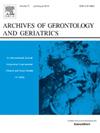COMPARISON OF THE EFFICACY OF NEW AND CONVENTIONAL ANTIPSYCHOTIC DRUGS IN THE TREATMENT OF BEHAVIORAL AND PSYCHOLOGICAL SYMPTOMS OF DEMENTIA (BPSD)
IF 3.5
3区 医学
Q2 GERIATRICS & GERONTOLOGY
引用次数: 0
新型与传统抗精神病药物治疗痴呆(BPSD)行为与心理症状的疗效比较
这项双盲研究评估了利培酮或奥氮平与丙嗪治疗痴呆(BPSD)行为和心理症状的有效性和安全性。患者的年龄要求为65岁或以上,患有DSM-IV诊断的阿尔茨海默病(AD)、血管性痴呆(VD)或两者兼而有之。所有患者均行颅脑CT检查;60例痴呆患者,男性27例(45%),女性33例(55%)。加州大学洛杉矶分校神经精神量表(NPI)在基线时进行,然后在4周和8周后进行。患者的得分至少在24分以上。采用Hoehn和Yahr量表评估帕金森病。这些量表是由一个不知道病人的治疗方式的审查员管理的。在10天的洗脱期后,20名患者,9名男性和11名女性,平均年龄76.6 +/- 6.0岁,随机分配托利培酮1mg,每天分次服用(早晨和睡前)(a组);20例9男性和11个女性,平均年龄82.5 + / - 9.3年被随机分配到奥氮平在睡前5毫克(B组)和20例,9男性和11个女性,平均年龄77.6 + / - 4.6年,被随机分配到丙嗪50毫克每日(早晨和睡前)(C组)。在缺乏临床反应的情况下,4周后,剂量可以增加到2毫克/天利培酮、奥氮平10毫克/天,100毫克/天丙嗪在各自的团体。采用重复测量方差分析对评分量表随时间(基线、4周和8周)的统计分析。在第8周结束时,80%的利培酮和奥氮平治疗的患者整体改善,而65%的丙嗪治疗的患者(p < 0.01)。结果表明,利培酮1 ~ 2 mg/d和奥氮平5 ~ 10 mg/d治疗BPSD有效、安全。利培酮表现出一种主要的剂量依赖性抗多巴胺能作用,当幻觉和妄想是主要症状时似乎更可取,即使它对攻击和游荡有很好的效果。奥氮平的镇静效果似乎更快,可能是对H1受体的阻断。此外,5-HT6拮抗剂可能有利于乙酰胆碱的释放,这解释了为什么这些患者没有出现认知恶化。然而,这两种药物都与丙嗪相当甚至优于丙嗪,其抗胆碱能和锥体外系特性的副作用明显更少。
本文章由计算机程序翻译,如有差异,请以英文原文为准。
求助全文
约1分钟内获得全文
求助全文
来源期刊
CiteScore
7.30
自引率
5.00%
发文量
198
审稿时长
16 days
期刊介绍:
Archives of Gerontology and Geriatrics provides a medium for the publication of papers from the fields of experimental gerontology and clinical and social geriatrics. The principal aim of the journal is to facilitate the exchange of information between specialists in these three fields of gerontological research. Experimental papers dealing with the basic mechanisms of aging at molecular, cellular, tissue or organ levels will be published.
Clinical papers will be accepted if they provide sufficiently new information or are of fundamental importance for the knowledge of human aging. Purely descriptive clinical papers will be accepted only if the results permit further interpretation. Papers dealing with anti-aging pharmacological preparations in humans are welcome. Papers on the social aspects of geriatrics will be accepted if they are of general interest regarding the epidemiology of aging and the efficiency and working methods of the social organizations for the health care of the elderly.

 求助内容:
求助内容: 应助结果提醒方式:
应助结果提醒方式:


